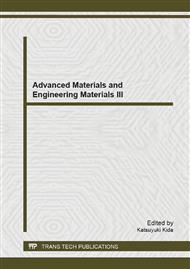[1]
B.H. Ahmadi, Behavior of composite timber-concrete floors. In Journal of structural engineering New York, 1993, volume 109. number11, pp.3111-3130, ISSN: 07339445.
DOI: 10.1061/(asce)0733-9445(1993)119:11(3111)
Google Scholar
[2]
A. Manaridis, Evaluation of timberconcrete composite floors. Lund: Lund Universitet. (2010). 131 pp. ISSN 0349-4969.
Google Scholar
[3]
B. Koželouh, Concrete structures according to Eurocode 5: Step 2, 1st ed., Praha: Inforamtion center ČKAIT. 2007. 375 pp. ISBN 80-86- 769-13-5.
Google Scholar
[4]
A. Lokaj, K. Vavrušová, E. Rykalová, Application of laboratory tests results of dowel joints in cement-splinter boards VELOX into the fully probabilistic methods (SBRA method). In Applied Mechanics and Materials. 2011, volume 187. Number 1, pp.95-99.
DOI: 10.4028/www.scientific.net/amm.137.95
Google Scholar
[5]
E. Steinberg, R. Selle, T. Faust, Connectors for timber-lightweight concrete composite structures. Journal of structural engineering ASCE. 2003. Volume 129. number. 11, pp.1538-1545. ISSN 0733-9445.
DOI: 10.1061/(asce)0733-9445(2003)129:11(1538)
Google Scholar
[6]
A.M.P.G. Dias, S.M. R . Lopes, J.W.G. Van de Kuilen, H.M.P. Cruz, Load-carrying capacity of timber-concrete joints with Dowel-type fasteners. Journal of structural engineering ASCE. 2007, volume 133. Number 5, pp.720-727. ISSN 0733-9445.
DOI: 10.1061/(asce)0733-9445(2007)133:5(720)
Google Scholar
[7]
P. Janas, M. Krejsa, V. Krejsa, Structural reliability assessment using a direct determined probabilistic calculation. In Proceedings of the 12th International Conference on Civil Structural and Environmental Engineering Computing. Funchal, Madeira, 1. -4. September 2009. ISBN 978-190508830-0.
DOI: 10.4203/ccp.91.72
Google Scholar
[8]
A. Lokaj, P. Marek, Simulation-based Reliability Assessment of Timber Structures. In Proceedings of the 12th International Conference on Civil Structural and Environmental Engineering Computing. Funchal, Madeira, 1. -4. September 2009. ISBN 978-190508830-0.
DOI: 10.4203/ccp.91.148
Google Scholar
[9]
D. Mikolasek,O. Sucharda,J. Brozovsky, Analysisof composite timber-concrete ceiling structure by finite element method. 3rd International Conference on Civil Engineering, Architecture and Building Materials, CEABM 2013, Applied Mechanics and Materials, Vol. 351-352, 2013, pp.254-259.
DOI: 10.4028/www.scientific.net/amm.351-352.254
Google Scholar
[10]
R. Cajka, K. Burkovic, Coupled timber-concrete ceiling using bonded shear connectors. Advanced materials research. Volume 772. Pp. 130-135. September 2013. DOI 10. 4028/www. scientific. net/AMR. 772. 130.
DOI: 10.4028/www.scientific.net/amr.772.130
Google Scholar


